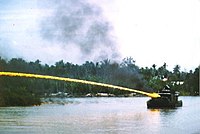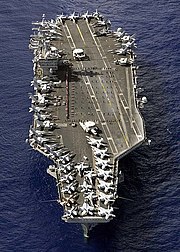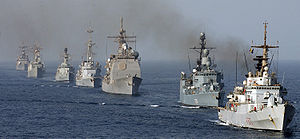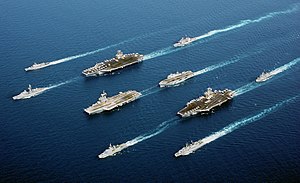Traditions
A basic tradition is that all ships commissioned in a navy are referred to as
ships rather than vessels. The prefix on a ship"s name indicates that it is a
commissioned ship. For example, USS is an acronym which expands to United States
Ship; in the Royal Navy, HMS expands to Her Majesty"s Ship (or when a King
reigns, His Majesty"s Ship), and so forth.
An important tradition on board British naval vessels (and later those of the
U.S. and other nations) has been the ship"s bell. This was historically used to mark
the passage of time on board a vessel, including the duration of four-hour
watches. They were also employed as warning devices in heavy fog, and for alarms
and ceremonies. The bell was originally kept polished first by the ship"s cook,
then later by a person belonging to that division of the ship"s personnel.
Another important tradition is that of Piping someone aboard the ship. This
was originally used to give orders on warships when shouted orders could not
have been heard. The piping was done by the ship"s boatswain and therefore the
instrument is known as the boatswain"s Pipe. The two tones it gives and the
number of blasts given off, signify the order given. It is also used in a
ceremonial way, i.e., to "pipe" someone aboard the ship - usually captains,
including the ship"s captain, and more senior officers.
In the United States, in a tradition that dates back to the Revolutionary War, the First Navy Jack is a
flag that has the words, "Don"t Tread on Me" on the flag.
By European tradition, ships have been referred to as a "she". However, it
was long considered bad luck to permit women to sail on board naval vessels. To
do so would invite a terrible storm that would wreck the ship. The only women
that were welcomed on board were figureheads mounted on the prow of the ship. In
spite of these views, some women did serve on board naval vessels, usually as
wives of crewmembers.
Even today, despite their acceptance in many areas of naval service, women
are still not permitted to serve on board U.S. submarines. The major reasons cited by the U.S. Navy
are the extended duty tours and close conditions which afford almost no privacy.
[1] The UK Royal Navy has similar restrictions. Australia,
Canada, Spain and Norway have opened submarine service to women sailors,
however. [2]
By ancient tradition, corpses on board naval vessels were buried at sea. In the past
this involved sewing the body up in a shroud that had a weight at one end, often
a cannonball. (During the age
of sail, the final stitch was placed through the nose of the victim, just to
make sure they were really dead.) The body was then placed on a pivoting table
attached to the outer hull, and shrouded by a national ensign. After a solemn
ceremony, the board was tilted and the body dropped into the deep. Later
ceremonies employed the casket or crematory urn.
The custom of firing cannon salutes
originated in the British Royal
Navy. When a cannon is fired, it partially disarms the ship, so firing a
cannon for no combat reason showed respect and trust. The British, as the
dominant naval power, compelled the ships of weaker nations to make the first
salute. As the tradition evolved, the number of cannon fired became an
indication of the rank of the official being saluted.
Reza & Sintha









